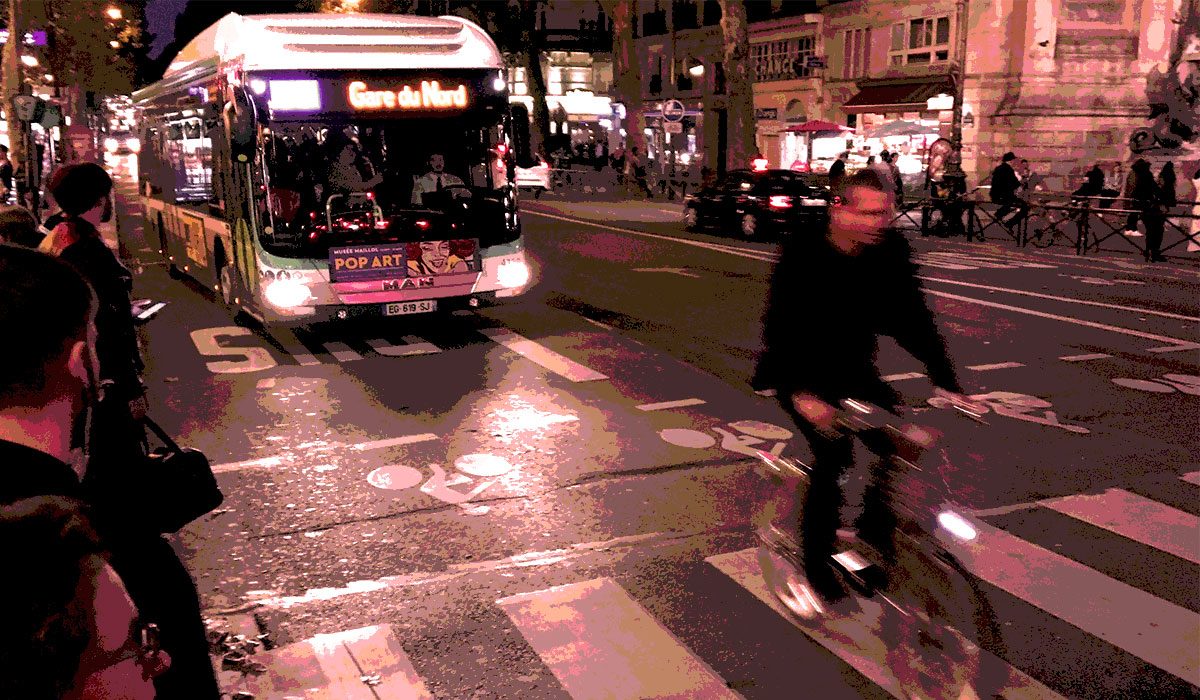
(Photo: J. Maus/BikePortland)
It’s time for bike, e-mobility, and transit riders to team up against the real enemy. With the Rose Lane project underway and e-bikes on the horizon, Portland should consider more carfree lanes.
– A guest opinion from Portland resident Henry Miller
“I am a lover of our bike lanes and our bike share system, but holy-moly we ain’t seen nothing yet.”
It would have been easy to start panicking when I hopped on my first e-assist rental bike. The buttons were sticky, the screen was difficult to decipher, cars were buzzing by, the cobblestones were slick from rain and, oh yeah, I was four thousand miles away from Portland’s familiar bike lanes.
Fortunately, and I was not prepared for this, biking across Paris is a dazzling dream made up of plentiful bike lanes, famous architecture, and soft-spoken French automobiles. But best of all, was riding the Parisian bike share system’s e-bike in the city’s many shared bike/transit/taxi lanes.
As an employee of Biketown, I know our bike system. I know how to zip from northeast Mississippi to the South Waterfront while almost never rolling outside a designated bike lane. I am a lover of our bike lanes and our bike share system, but holy-moly we ain’t seen nothing yet.
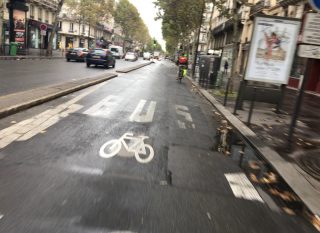
(Photo: J. Maus/BikePortland)
It’s not hard to imagine the benefits of an e-bike — no distance is too far, no hill to steep, and no sweaty armpits when you get to your destination. Yet having superbikes, which are expected to come to Biketown next year, only addresses half of what makes a bike system great. The other half is bike infrastructure that makes biking (and all micro-mobility vehicles for that matter) as appealing as driving. Paris accomplishes the second feat by dedicating entire lanes on crucial streets across the city to bus, taxi (but not Lyft or Uber), bike, and e-mobility (scooters mostly) riders.
At first glance, that did not seem like a good idea. I was terrified of ending up in front of a flustered cabbie or, infinitely worse, under the wheel of a bus. Then I realized something as I darted from landmark to landmark and commercial street to neighborhood alley: I wasn’t sharing the lane with bus drivers because we are the same size or same speed, but because people in cars outnumber us. I wasn’t using bike infrastructure. I was using carfree infrastructure. This is the perspective shift that could allow Portland to provide better transit, better bike, and better e-mobility systems at the same time.
Advertisement
When treated individually, dedicating streets to buses or bikes is challenging from both traffic engineering and political standpoints. When the Portland Bureau of Transportation tried to improve the Clinton Street by diverting drivers off of it, the controversial result was more drivers using adjacent streets. And I’ve heard many complaints about how PBOT has made it harder to drive without providing adequate alternatives.
This lack of an alternative might explain why TriMet ridership has dropped even as Portland’s roadways are dealing with L.A. levels of congestion. Hey, would you rather be stuck in traffic on a crowded bus, or in your own car?
PBOT is attempting to fix that problem with their groundbreaking Rose Lane Project. This project is likely to get pushback from the same people who point out that, at least for now, bus lanes will only be used by a sliver of Portland’s commuters (compared to drive-aloners). It’s a fair argument, and the fastest way to weaken it is to put more people — not just bus riders — in those lanes.
By creating a lane that serves bicycle, bus, e-scooter, and e-bike users, we combine the interests of more commuters and provide a stronger justification for “taking a lane away” from drivers. We also create carfree lanes that can be implemented on some of our retail and commercial corridors, giving many more people a way to access popular destinations where neighborhood greenways come up short.
Advertisement
But would these carfree mixed lanes feel safe? If they are anything like what is in Paris, absolutely.
“For the most part, biking along a transit lane in Paris means having the road to yourself.”
For the most part, biking along a transit lane in Paris means having the road to yourself. At their fastest, most buses don’t arrive at a station closer than 8-10 minutes apart. Spatially, those minutes contain hundreds of yards of unoccupied street, where a bicycle user can move at their own speed and enjoy a ten-foot-wide bike lane. These gaps made it feel much safer to pass or be passed by scooter users and other bike riders, as well as cab drivers.
When bus drivers do come along, their vehicles are big, slow, and predictable — even with their own lane. This makes them easy to spot and navigate around, at least compared to the kinds of drivers I’ve run into on the Clinton Street greenway – which includes everyone from heavy-duty pickup truck drivers to teens in sports cars, to SUV driving soccer moms.
Portland already has small segments of carfree lanes where bus and bike riders mix. We now have a golden opportunity with the Rose Lane Project to take things to the next level.
Of course, these carfree lanes won’t stay safe and sane forever. Eventually the high volume of people on bikes, scooters, and who knows what else maneuvering around articulated buses on streets like Broadway and Hawthorne will be enough to create serious safety hazards. No big deal. When that happens, Portland’s carfree lanes could quickly absorb a second lane with a few stripes of paint — a process that will be so much easier when nobody wants to drive anymore because our transit and micro-mobility systems are that much better at getting Portlanders where we want to go.
— Henry Miller (website)
— Get our headlines delivered to your inbox.
— Support this independent community media outlet with a one-time contribution or monthly subscription.



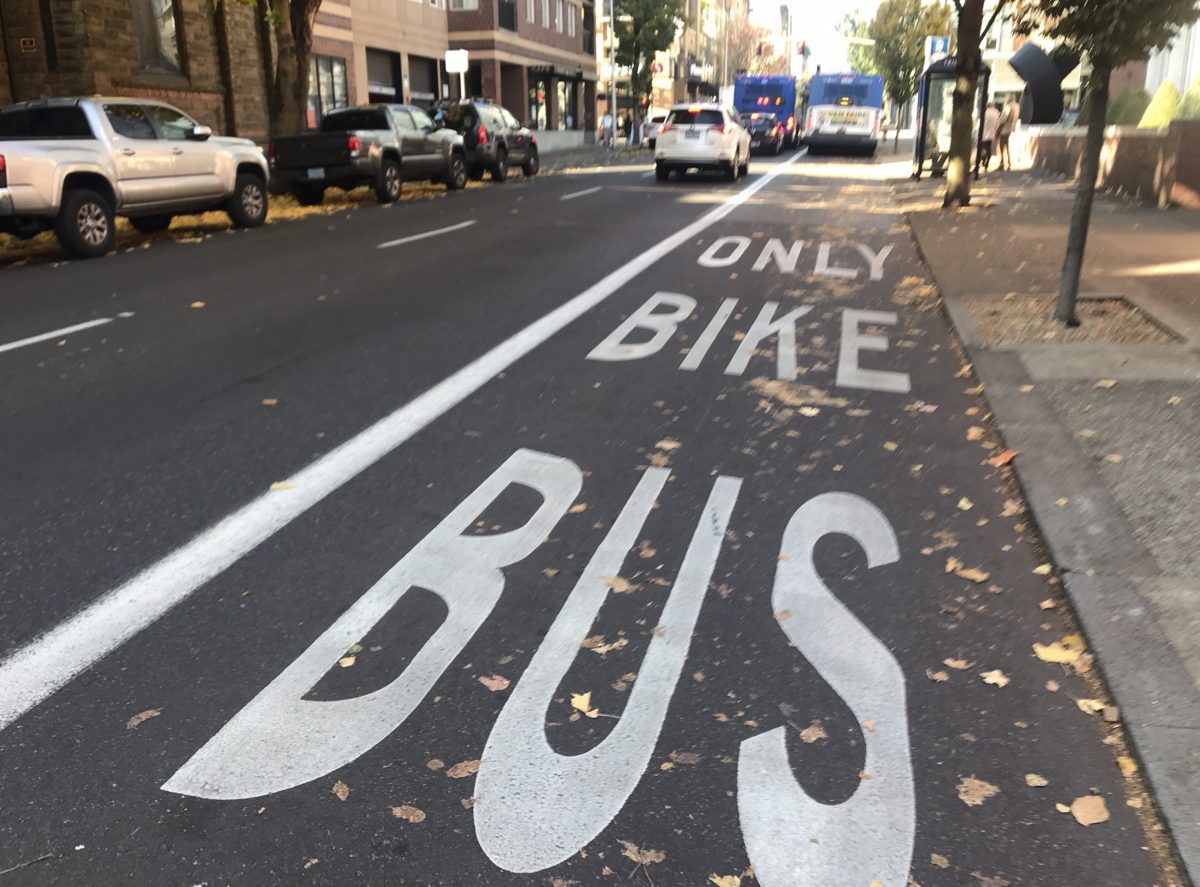
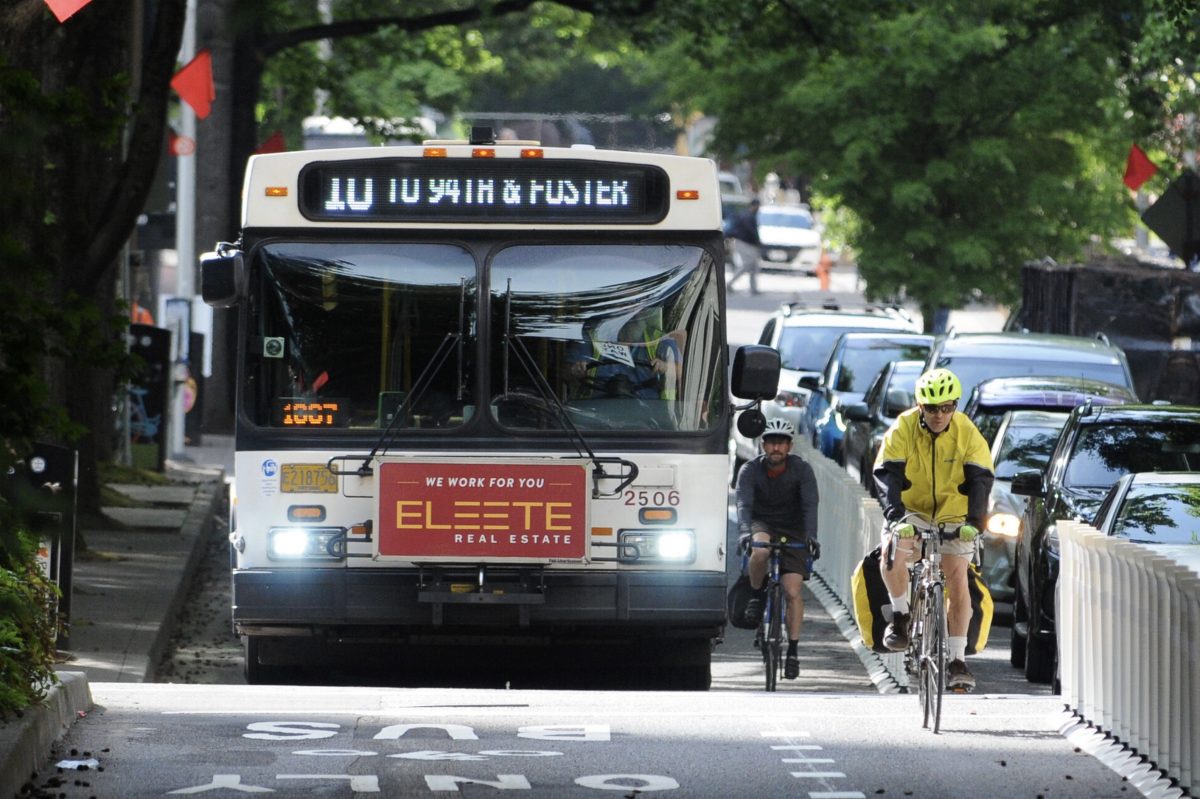
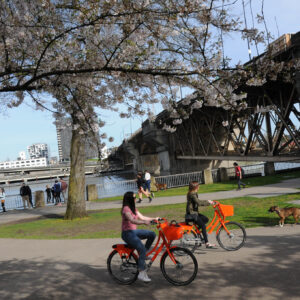
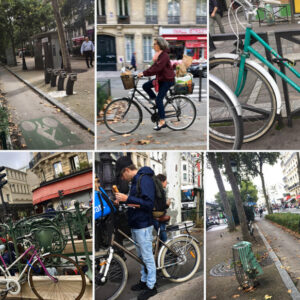
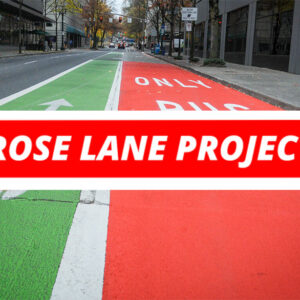
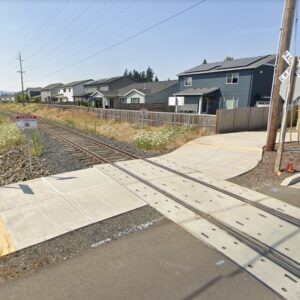
Thanks for reading.
BikePortland has served this community with independent community journalism since 2005. We rely on subscriptions from readers like you to survive. Your financial support is vital in keeping this valuable resource alive and well.
Please subscribe today to strengthen and expand our work.
Thanks for sharing this story and your experience using Paris’ car-free lanes! It’s encouraging to hear this first hand experience of how accessible and connected a complete, car-free network can be for transit and cycling alike.
Thanks for the excellent article. I have one minor quibble:
I don’t think the 8- to 10-minute intervals between buses are going to hold up on a lot of Portland routes. Look at SW Barbur at rush hour, which is frequented by the 1, 12, 44, 45, 54, 55, 56, 61, 64, and probably even more bus lines. Ride Barbur during rush hour and you’ll be passed by one, two, and sometimes even three buses every 1-2 minutes.
Also the idea of taxis in the lanes seems somewhat daunting. Nice that Paris keeps the Lyft and Goober drivers out of the lanes, but taxi drivers also should get special training in how to share these lanes.
I would much rather share a lane with drivers who know what they are doing than with the general driving public, but I wonder if these dedicated lanes have an advantage over bike lanes only in places where there are no bike lanes.
Taxis are not public transit, and should never be given priority.
In much of Europe, but especially in Britain, bus service is privately run & operated, not a public service (though it is heavily subsidized.) Since taxi services are heavily regulated in Europe, they are seen as “public transport” as much as city buses are. Often you’ll see red lanes marked “Bus, Taxi, & Bike Only”. Even in much of the US, “public bus service” is often contracted out to the big 5 commercial operators, two of which are British (National Express & First Transit) and 3 French (RATP [Paris mass transit corporation], Keolis [70% owned by SNCF – French National Railways], & Transdev [70% owned by the Bank of the French government]), such as in Boston.
Are you saying that bus service in Boston is privately owned?
No, in Boston the bus service is public, but the service is contracted out to a foreign corporation (Keolis) who manages the personnel, maintains the buses, and coordinates flow. The public agency owns the buses, rail lines, offices, and has various public personnel. But if you visited Boston, you’d have difficulty distinguishing between the contracted personnel and the public personnel as they usually wear similar uniforms. There’s a lot of that nationwide, especially for university/college transit, paratransit, and airport shuttles, but also for many public fixed-route services. In Portland for example, TriMet contracts out to Ride Connection for a good deal of its paratransit service, who then supply their drivers, buses and vans, and administration.
A street with that many bus lines could have a bus lane -and- a bike lane, especially since it parallels a major highway dominated by private automobiles and big trucks.
Bus 56 needs to be rerouted to serve the southwest edge of Beaverton, then Progress Ridge shopping center, and the rest of Scholls, and then to Sylvan and the Washington Square MAX station. A bus-on-shoulder state legislation like Washington state would help Oregon’s freeways and congestion (bus 56 could use the shoulder on highway 26 if a law were passed). Then bus 54 would stay on the same route but with more service.
Bus-on-shoulder operation is a clever use of the space but also a plastic strip bandage sort of thing. See David Hampsten’s comments about weak pavement at the edge of the road. Buses weigh a lot.
I find sharing a lane with a bus to be not awesome because even though they only come every 15 minutes you often end up in a leapfrog situation with them where you are passing one another as the bus stops to pick up passengers. I wonder if e bike riders will not have this issue because even a slight increase in the speed you are travelling will mean once you pass the bus it likely won’t catch up to you again.
A bus in a lane with no cars will be a different animal. For one thing the operator will not be, like, 8 minutes behind schedule. You know why bus drivers get wound up? They don’t know how long it will be before they get to pee.
From my travels to Europe and visiting over 50 different towns and cities, I have observed that urban cyclist there tend to move a lot slower than American urban cyclists, they don’t even work up a sweat. Buses also go much slower on the often narrow urban streets that are moreover crowded with pedestrians jay-walking everywhere, so they too move at a much lower speed, usually under 15 mph.
Unfortunately, European suburban areas often imitate US suburbs all too much – they are usually more urban, but pedestrian movements are more restricted and cars & buses move all too fast, plus they too have strip malls and big-box retailers (hypermarkets).
“the controversial result was more drivers using adjacent streets.”
This is not supported by the data. Once PBOT finished the diverter and associated improvements to adjacent streets, traffic counts were approx the same as before (with small increases and decreases).
See 2017 and 2018 counts near 17th and 32nd diverters here: https://pdx.maps.arcgis.com/apps/webappviewer/index.html?id=7ce8d1f5053141f1bc0f5bd7905351e6
I concur. I was in Winston-Salem recently (an industrial city of 275,000 people) where they are rebuilding a freeway that passes through the center of town. Naturally, they predicted that by closing the freeway, businesses would suffer, existing alternative streets would be congested, etc. Well, they closed off the highway, but business is thriving, congestion has gone down, and walking is much improved. Which now begs the question – why rebuild the highway? Why not make it an 8-lane bike/ped/bus/park way?
I wish the “controversial result” was the result of PBOT closing ALL of Clinton to cars as they made it the citys’ first car-free greenway (of many).
What do all the people who live on Clinton and own a car supposed to do then?
Do city buses use Clinton?
One bus line, the 10, uses Clinton from SE 21st to SE 26th.
As a pedestrian, I think the important point is that bikes (and modes of similar speed) need to be separated from pedestrians. I’m often scared when walking on the Springwater by bikes passing me at 20mph from behind with warning of only a fraction of a second. In the long run dense cities should devote the scarce resource of street area to more compact modes of transportation (pedestrian, scouter, bike), while big vehicles are confined to special occasions (delivery of people or goods).
Jonathan – thanks for your report. I had the same positive experience with that arterial (Boulevard Saint-Germain) in 2003 (but not on an e-bike) during my last long visit to Paris. The big takeaways from that experience is that experienced cyclists can share a ~16FT transit lane with trained / professional operators of local transit (not express buses) with low speeds/ many stops. These lanes are generally wider than US transit lanes and there is (was in 2003) a network of shared streets with sharrows paralleling this route for less experienced cyclists (or cyclists with wide loads / kids etc.)
The article raises an interesting point: The more users that are allowed into bus priority lanes, the more politically viable they are. At the onset, bus-only sounds like an inefficient use of road space, but if other user groups are allowed, the needle shifts toward a political tipping point. The question is how many other groups do we need to get these lanes?
I would would argue that adding ride hailing cars to Portland bus lanes would be no more of a compromise than allowing taxis into Paris bus lanes. Paris has about 18,000 taxis compared to about 10,000 taxis + ride hailing cars in Portland, according to quick Internet search.
Granted Paris is a much larger city, but my own personal impression is that taxis are much more common in Paris that Uber/Lyft/Taxis are here. In any case, I think a multi-modal green lane, where buses will get a speed advantage over personal cars, would be a huge win. In time, this is the very thing that will drive up TriMet ridership. If joining hands with the ride hailers helps make it happen, it might be worth it.
Uber and Lyft are one of the main culprits for declining mass transit use. Instead of further subsidizing predatory companies that abuse the commons, we should ban them or regulate them out of existence.
https://usa.streetsblog.org/2019/01/22/study-uber-and-lyft-are-responsible-for-u-s-transit-decline/
I don’t want to defend Lyft and Uber. But the ride hailing concept is a good one because it meets a previously unmet demand at a price people are willing to pay.
When you’re trying to get anywhere in PDX on off-peak hours, it’s a drag with TriMet. Who wants to wait on a dark street corner for 40 minutes until the next TriMet bus gets there? Not me.
Instead of banning ride hailers, why not levy a road-use fee on them and funnel the revenue to better pubic transit? This would help close the competitive gap between transit and ride hailers, while also improving sustainability and maintaining a decent menu of transport options.
I would support your idea, but transit will never be able to compete with “ride sharing” except possibly on nominal cost. It’s not even clear to me that our current transit system is significantly ecologically superior to Uber and Lyft.
Add up all the energy TriMet uses moving people around, and divide by the number of people, and compare to a newer model car. My prediction is that transit is better, but not by much. Anything we do to make transit more convenient (more frequent service in the off-hours, more routes, etc.) will (likely) make that comparison worse.
To improve the comparison, we need existing transit vehicles to have more passengers per trip, which, except in the off off hours, riders don’t generally like.
TriMet does compete with ride sharing, just not very well. Neither does it do well vs. private cars. This isn’t a given, it’s partly a matter of political choice on what sort of transit we want and how we manage our roads. On the bus, you’re never going to get the privacy of cars, but with investment and road-space reallocation, buses could compete in terms of speed and convenience, which I believe are the top two criteria for most commuters. TriMet could also improve passenger information systems and upgrade its buses so they’d have clean, appealing interiors and electric or biofuel motors. This would change the calculus around environmental impact. And regardless of emissions, mass transit already beats personal cars by a long shot in terms of congestion.